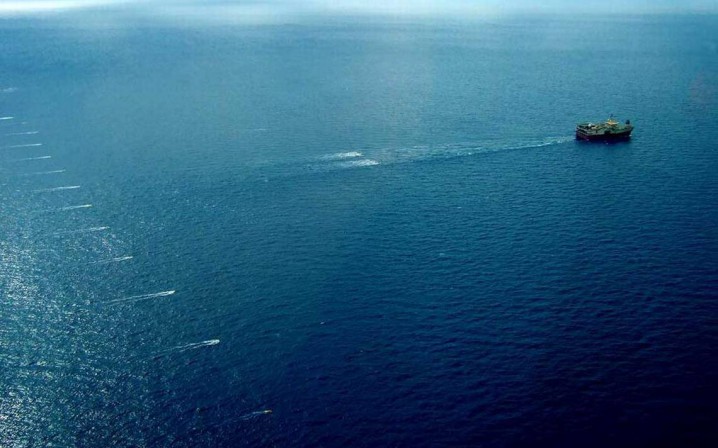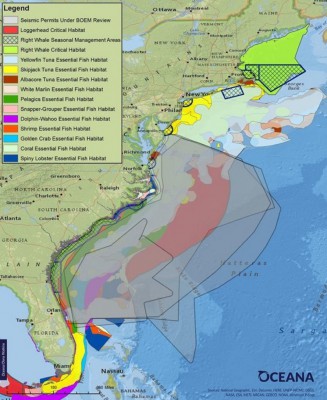
JACKSONVILLE – The prospect of seismic testing in search of oil and gas resources off the North Carolina coast is once again on the table.
The Department of Interior earlier this month rescinded the January denial of permit applications from six seismic testing companies aiming to conduct surveys in the Mid- and South-Atlantic outer continental shelf.
Supporter Spotlight

Interior Secretary Ryan Zinke signed an order May 10 that forges ahead President Donald Trump’s agenda to explore energy resources in the Atlantic.
Secretarial Order 3350 reverses former President Barack Obama’s order in January to the Bureau of Ocean Energy Management, or BOEM, to deny permit applications from companies seeking to conduct geological and geophysical, or G&G, activities off the East Coast from Delaware to Florida.
“That decision underestimated the benefits of obtaining updated G&G information and ignored the conclusions of BOEM’s Atlantic G&G Programmatic Environmental Impact Statement and Record of Decision, which showed that no significant impacts are expected to occur as a result of these seismic surveys,” according to a release from the Interior Department.
This statement is contradictory to comments made by former BOEM Director Abigail Ross Hopper, who, in a written directive denying the applications, expressed concerns about the potential harmful effects of seismic testing on marine mammals.
Seismic testing uses air guns towed behind ships to send sonic waves that penetrate the ocean floor. How those waves are reflected from the bottom gives hints to the location and extent of oil or natural gas deposits below the surface.
Supporter Spotlight
Seismic operations are controversial because the use of sound may disturb the normal behavioral patterns of marine mammals.

“As far as the impact goes, the chances of an animal being outright killed by seismic air gun arrays are slim,” said Doug Nowacek, a professor at the Duke Marine Lab and one of the world’s leading experts on marine mammals. “The effects that we worry about mostly is producing sound in their environment and that’s the sensory mode they use.”
Seismic air gun blasts create background noise, making it harder for marine mammals to hear each other, their young and predators.
Not only does this background noise disrupt communication, it may cause physiological distress, altering the animals’ migration patterns, feeding, and, even reproduction.
The Atlantic Ocean hosts a diversity of mammals, about 30 or so that include humpback and North Atlantic right whales and dolphins. These species, as well as sea turtles, are among those that could be affected by the use of airguns conducting seismic operations.
The G&G industry maintains that there are mitigation measures in place to reduce the effects on marine mammals.
The Trump administration has directed BOEM to develop a new five-year program for offshore oil and gas exploration, though it is unclear how long the permitting review process may take.
“Under the executive order from the president, he did ask that we streamline the process or find ways to streamline,” said Connie Gillette, BOEM’s chief of public affairs. “I think it’s not unreasonable to say that it could be a year or two years. There’s multiple things that have to happen. It just takes a while.”
Before applications get the all-clear they must be approved by the National Oceanic and Atmospheric Administration’s, or NOAA, fisheries. The National Marine Fisheries Service, or NMFS, reviews all proposed seismic activities for incidental “takes” — the inadvertent harming, killing, disturbance or destruction of wildlife — anticipated during such testing.
Permits and authorizations for the “take” of a protected species are required under the Marine Mammal Protection Act and the Endangered Species Act, the future of which is uncertain under the current administration.
Incidental harassment authorizations, or IHAs, may be released in the coming weeks, during which time the public will have the opportunity to comment.
IHAs typically contain a variety of mitigation measures.
“Some of those hopefully should be time-area closures, including Cape Hatteras,” Nowacek said.
He describes this area where, in a typical day, you can expect to see four to five different species of whales, various sea turtle species and hammerhead sharks, as “the marine equivalent of the Serengeti.”
Environmental groups, including Oceana, which has been a leader in campaigning against seismic testing, have begun again to rally in opposition to prospective seismic testing in the Atlantic.
A representative with the American Petroleum Institute did not respond to a request for comment.
 International Association of Geophysical Contractors, or IAGC, President Nikki Martin lauded the Trump administration’s decision to reopen permit application reviews.
International Association of Geophysical Contractors, or IAGC, President Nikki Martin lauded the Trump administration’s decision to reopen permit application reviews.
“Offshore seismic surveys have a long history of providing an accurate assessment of our nation’s oil and natural gas resources in an environmentally safe manner, critical to informing an effective national energy strategy and future OCS leasing decisions and plans,” Martin stated.
The IAGC represents more than 125 G&G companies.
The industry defends offshore energy exploration methods, saying there’s no scientific evidence that links the sound from air gun blasts to the deaths of whales and other marine life.
Industry officials argue that existing G&G survey data, collected more than 30 years ago, is outdated.
In her directive to deny seismic testing permit applications, Hopper wrote that there are currently moves to develop “quieting” technology for seismic surveys.

BOEM in 2014 hosted a workshop that including government, industry, environmental groups and researchers to “gain a better understanding of these emerging technologies.”
“The most promising alternative to airguns appears to be marine vibroseis technology,” Hopper wrote.
Vibroseis reduces the loud “shot” of air gun surveying by spreading the energy used to create the sound over a longer duration.
“The economic feasibility of this technology remains to be proven and the potential environmental impacts tested,” Hopper wrote. “There is no silver bullet. However, by engaging industry and the regulators, I expect technologies will be developed that can produce data that is commensurate to that being produced by currently available airgun seismic survey techniques, but with much less environmental impact.”
Such technology “should absolutely be part of the equation,” Nowacek said. “I think it would be irresponsible for BOEM and NMFS to not evaluate the new technology like vibroseis. What people need to understand is that it’s not just a one-time thing. They go out there and, if they find some areas that look promising, they’re going to want to shoot seismic every three to five years.”
The G&G companies that have applied to conduct seismic testing in the Atlantic would be overlapping the same test areas, particularly off the coast of Cape Hatteras, he said.
“Why don’t we just have one survey and then everyone buys the data as they need it?” Nowacek asked. “That is what we mean by wise use of resources while mitigating the impacts to the environment.”







